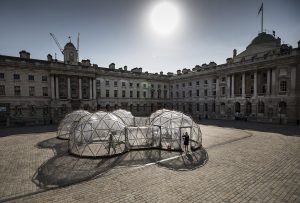
Over the last months I’ve been doing lots of research and work around the climate crisis in relation to city change in London. This so far has involved lots of reading, visiting conferences, talking to artists, designers, academics and loads of others inspiring people active in that area.The writer Amitav Ghosh talks about the climate crisis is a ‘crisis of culture, and thus of the imagination’ which I find particularly poignant. An ongoing thread has been the idea that future generations will look back and not just blame politicians and governments for not acting strongly enough on the climate crisis, but that they will also look to the artists and great thinkers of our time and ask why more wasn’t done to co-imagine more radical and positive futures together with citizens.
Like in many cities, air quality is a critical issue in London and over the past few years I’ve developed quite a number of different projects relating specifically to that theme. Most recently, I worked with artist Michael Pinsky to bring work Pollution Pods to Somerset House, which was part of our overall Earth Day programming in April. That particular work referenced other cities such as Delhi, Beijing and Sao Paulo and audiences were immersed in the artist’s impression of the temperature, humidity and smell of each of those places, making sense of the different reasons for pollution in cities internationally. Thousands of people came to see the installation, and many reflected how that particular artwork sparked conversations of a very complex global scale, but was also effective and emotive because it engaged audiences in a much more individual way that had a really direct connection to everyday life and wellbeing.
I’m really interested in this relationship between local and global, and bringing global stories and narratives into everyday ways of living in the city we live in. A good example is around fast fashion and the great work Fashion Revolution does connecting consumers with questions of ‘who makes your clothes’ and subsequently encouraging people to think about how they shop and the broader human and ecological impact of those everyday individual choices. Often everyday conversations within broader culture seem to end up focused on straws, single-use plastics or car usage. While all those thing are important conversations for citizens, culture and policy makers to be engaging in, one thing that I’ve been inspired by the range of different artists and organisations of all sorts who are instead focusing on issues of gender, class, representation and power in relation to these broader global challenges. For example, earlier in the month Invisible Dust organised an event at the British Library in London called Under Her Eye: Women and Climate Change which over two days delved deep into ideas about the role of cities in climate change, culture and activism and loads more which relate back to ideas and themes that emerged as part of the Creative Producers International residency last year.
Other recurring conversations in relation to culture and climate change are themes are issues of diversity and representation. A few weeks ago I attended a meeting at the House of Lords chaired by Baroness Lola Young as part of What’s Next?. Initiated by Somerset House residents Julie’s Bicycle the regular climate sub-group meeting brings together arts organisations of all different sorts. This particular meeting explored issues of diversity and representation within climate related artistic programming and a summary of that is available on the great platform WORM: Arts and Ecology. This subject area is something that Harpreet Kaur who is a fellow Creative Climate Leader has also been exploring in her recent interviews with artists around the UK as part her ongoing blog series Diversity and Climate Art: (New) Narratives on the Climate Story. Working across artistic disciplines these interviews profile artists working at the intersection of all these issues.
I recently spoke with Anel Moldakhmetova from Almaty in Kazakhstan, another of my Creative Producers International cohort, and who has also done loads of work and thinking related to citizen engagement in urban planning and also in environmental issues such as air quality. She talked about how when citizens are actively involved in for example collecting air monitoring data, they are more invested in the issues and become much more responsible. I find this really relevant when talking about the engagement of citizens in climate issues generally. The more ways that city dwellers are involved, the more co-responsible we all become.
As I develop projects and programming as part of Creative Producers International and also my work at Somerset House, these are some of the particular questions and ideas I’m exploring further:
Who are the pioneers working to diversify the creative sector, environmental activism, and urban planning respectively, and what can be learnt by connecting each of those areas and networks?
Which artists are working between these different areas already?
Whose voices are missing from conversations about climate change in the city, both locally and globally?
Who are the worst affected, and what role can technology play in creating sharing those stories in public spaces using Playable City approaches?
For more updates on Creative Producers International please sign up to our Playable City mailing list here.
